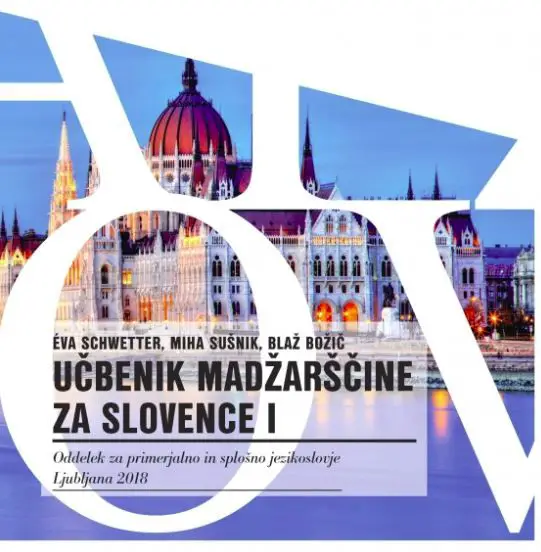Ljubljana related
Mladina: Government failing to protect national interest from Hungary
STA, 19 April 2019 – The left-leaning Mladina is critical of Slovenia's reluctance to protect its national interests in a commentary accompanying revelations about connections between the European Commission, the Hungarian government and a bank vying to take over Abanka. The weekly underlines that strong financial institutions are the backbone of a sovereign country.
Editor-in-chief Grega Repovž says that a journalist of Mladina found new connections between the Hungarian government and a Hungarian official at the European Commission who insisted that Slovenia privatise its banks.
The situation is becoming increasingly problematic because the revelations trigger doubts about the actions of those involved in Slovenia, as well as the expertise of the European Commission.
Mladina shows connection between the Hungarian government led by Viktor Orban and István P. Székely, who works for the commission, also highlighting the efforts of Hungarian OTP bank to take over Abanka, which is being privatised.
It wonders why the Hungarian Imre Balogh, who also has links to the Orban government, was appointed the CEO of Slovenian bad bank in 2015 and why Laszlo Urban, a member of Orban's party Fidesz, was appointed a member of the NLB supervisory board in 2016.
"What sort of network has the Hungarian government already woven in Slovenia, apart from the obvious links to the Democrats (SDS) and the media it bought from it?" the weekly wonders, adding that Ambassador Edit Szilágyiné Bátorfi had met privately with Slovenia's central bank governor Boštjan Vasle.
The world is changing and countries are pursuing increasingly selfish interests. "Small countries, above all, need to think very carefully about future relations and how to position themselves today to be safe from turbulence in the future."
But Slovenia does not have many experts capable of thinking so far in advance, Mladina says under the headline Time for the Wise.
Strong banks and financial institutions are the backbone of a country but the incumbent government does not seem to be aware of this.
It has not stopped the privatisation of Abanka although countries are fighting for "the last segment of Slovenia's financial backbone" in plain sight.
Demokracija: Politicians should not speak of media freedom
STA, 18 April 2019 – The right-leaning Demokracija says in its latest commentary that the concern for freedom of the press expressed by ruling politicians in the wake of the alleged pressures on the private broadcaster POP TV should be taken with a grain of salt, adding that journalists should actually be worried about politicians who are doing that.
The ruling politicians were quick to swear on democracy and presented themselves as defenders of media independence from politics and capital, but this care of politicians for freedom of the press should raise concern among journalists.
Friday's editorial headlined Riders of Freedom notes that, for instance, MEP Tanja Fajon of the coalition Social Democrats (SD) said on Twitter that "if there is no democracy, there could be no media freedom".
Fajon's idea that democracy ensures freedom of the press is wrong. It is the opposite: freedom of the press, individuals, expression and economy can ensure democracy, which manifests itself in various forms, the editor-in-chief of the right-leaning weekly, Jože Biščak, argues.
Slovenia has around 20,000 laws and by-laws and also has media legislation. "What is regulated by law cannot be free. The media are therefore not free, they are regulated. And the government will make media legislation only stricter."
Some have gone as far as proposing licences for journalists, which would be a very totalitarian thing, as an "expert committee" appointed by politicians would determine who is journalist and who is not.
They say this is a method to fight bad journalism, protect the public from fake media and fake journalists, and improve media professionalism. But this has no basis in reality, as despite the increasing regulation, there are a lot more media outlets today, and they are much more accessible to an average citizen.
"It is not up to the state or politicians to recognise the legitimacy of the media, it is up to every individual to choose freely what sources and media they will believe. This is how it goes in free societies."
Biščak concludes by saying that those who think that the majority of Slovenian citizens are not capable of differentiating between disinformation and information and that politics could "help" them in that, are inclined to dictatorship.
All our posts in this series can be found here
April 9, 2019
Last week ended with news of a strange diplomatic move on the side of Hungarian government, whose diplomatic representative to Slovenia, Edit Szilágyiné Bátorfi, sent a verbal note of protest (an official diplomatic tool of interstate communication) to the Foreign Ministry of Slovenia, demanding it “prevent” further “politically irresponsible” “incidents” on the side of the Slovenian media. The note was prompted by the cover of Mladina magazine depicting Hungarian president Viktor Orbán in a Nazi salute, guarded by three Slovenian SDS party members, all in presumable reference to the SDS’ struggles to prevent Orbán’s Fidezs from being kicked out of the European People’s Party. “We give up Europe, but we don’t give up Orbán”, read the title.
Over the weekend, media outlets in Slovenia that are part-owned by Hungarian interested that were established and run by sympathisers of the Janez Janša and members of his SDS party, issued a series of articles, that praise the formal and informal Hungarian protests and criticise the Slovenian government and Slovene Association of Journalists (SAJ) for having double standards with regard to media freedom. As a proof of the latter, Demokracija reminds readers of its own cover, which was not that long ago a target of criticism by both the SAI and the government for “spreading hate speech”, since, according to Demokracija, “these terms are arbitrarily defined by the left political pole”. Furthermore, Demokracija emphasised that following a “really tasteless depiction of a foreign country’s prime minister”, Mladina then “instead of normal communication, which would become a supposedly serious news media” went on to make jokes on account of the Hungarian ambassador’s protest.

Before news of the official diplomatic note of protest broke, it was only known that the ambassador had sent an awkwardly assertive letter to the magazine, expressing “a protest against the way in which Prime Minister of Hungary was depicted”. Also in this letter the Hungarian ambassador wondered whether Mladina’s goal was to “stoke hatred among nations”, reminded the editor that such “distortions of truth” are “especially severe and unacceptable in times of election campaigns”, and concluded with an appeal to Mladina “to stop the negative campaign against Hungary”, since “you offend millions of people by doing so”.
Mladina then responded with another, “corrected” version of the cover and an “apology” letter by the cover’s author, Tomaž Lavrič. Lavrič, the no. 1 Slovenian comic book artist who received a Medal of Merit for his Exceptional Contribution in the field of Slovenian Illustration, as presented by President Borut Pahor in 2015, along with the Prešeren Foundation Award in 2017, has collaborated regularly with Mladina as its “house caricaturist” since his first Diareja strip in 1988.
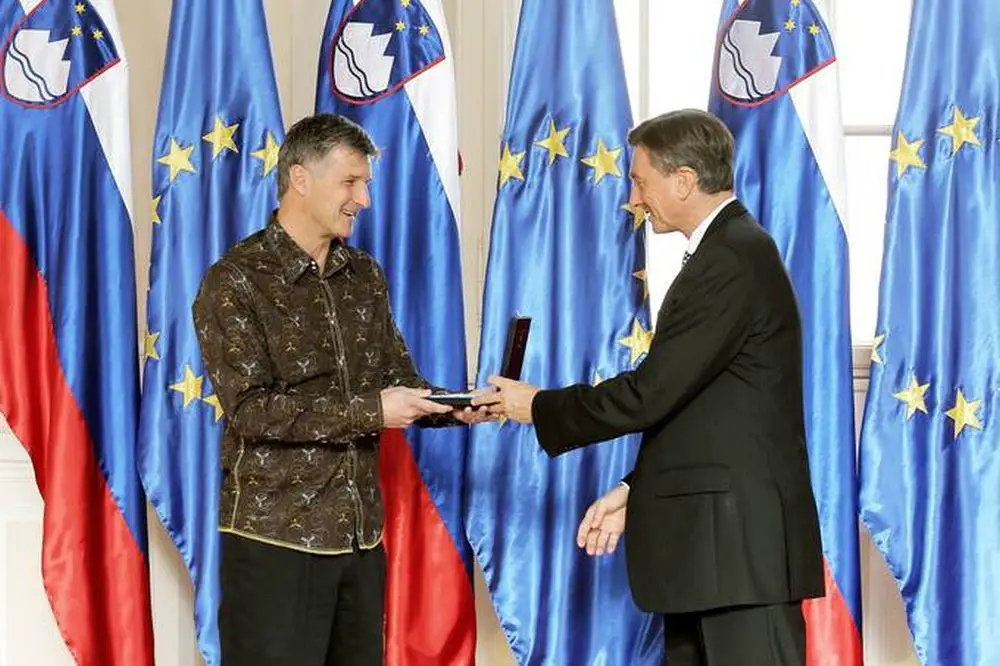
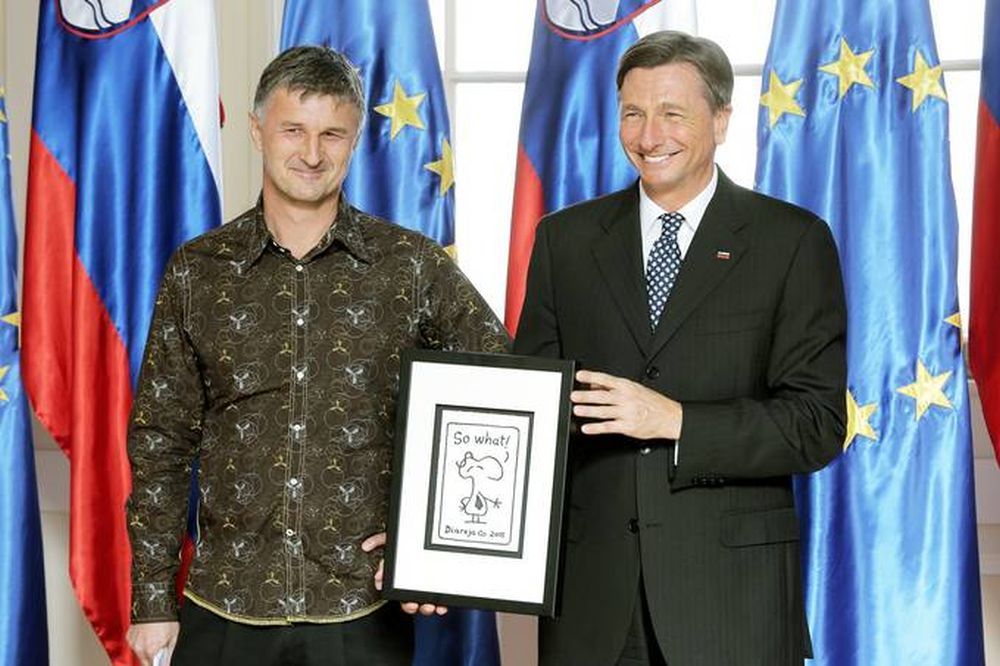
Apology
Much Honourable Madam Ambassador of the Republic of Hungary,
Accept my sincere and profound apology for a rude and completely untruthful depiction of your president Mr. Orbán on the cover of Mladina, which justifiably instigated your feelings of indignation and sadness.
After reading your concerned letter, I turned inside myself and realised my fault. I know that the anguish caused cannot be erased, but in my defence allow me nevertheless to explain that I myself am also just an innocent victim of objective circumstances. Let me point my finger at the real culprits of this undesirable scandal. These are:
- First, of course, a long-term communist education system which washed my brains and numbed my sense for nation and religion.
- Next to blame are my lackadaisical and inattentive superiors at the editorial board of Mladina, who should have better supervised me and stopped in time, as they know well that I am irresponsible and naïve in political matters, and just think that everything is allowed.
- And last but not least to blame is our permissive judiciary system, which fails to harshly and swiftly punish such social deviations.
I am urging you, madam, not to give up on us, but to continue to kindly help us with your advice and benevolent criticism, so that we too can achieve an exemplary state of objectivity and speak in one voice, as you have managed to establish in the Hungarian media, and that one day we too can live our lives under the rule of order and peace, national purity and Christian love for all the people behind the wire fence, as commanded by your mild and righteous beloved leader V. Orbán.
With all due respect,
Tomaž Lavrič, house caricaturist
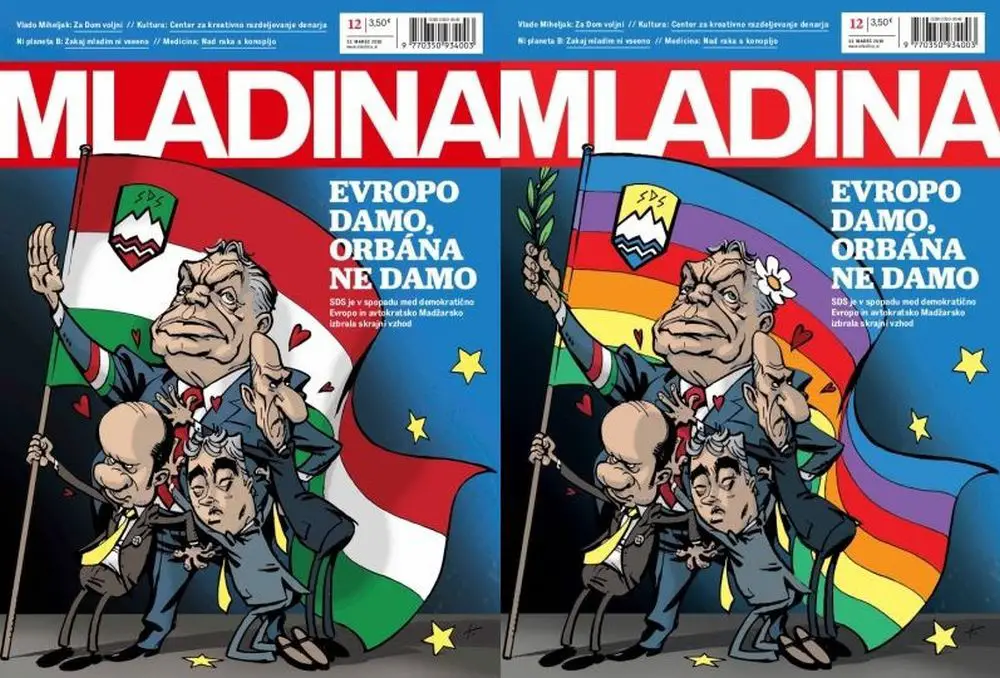
To explain the main problem behind the “outrageous” cover of Mladina, Demokracija also quoted the Hungarian government spokesperson Zoltán Kovács: “It’s an outrage and unacceptable first and foremost to the memory of the victims of that horrible period [World War 2]. Little surprise that the leftist editors at Mladina dislike the policies of the Orbán Government, but comparing the events of today’s Europe with the Nazi era trivialises what really happened in that dark time. (…) According to the author, Hungary’s firm opposition to immigration under the Orbán Government and our determination to protect European culture, which is deeply rooted in Christianity, is akin to the notorious German concept of Lebensraum.”
To understand the line of deduction here one might perhaps begin with the premise outlined by Milan Zver, MEP (depicted kneeling on the cover of Mladina) in his 2017 speech at the Pan-European Memorial for the Victims of Totalitarianism in Brussels: “Slovenia is the only state in the EU that has survived all three totalitarianisms: Fascism, Nazism and Communism. While the first two have practically disappeared, the process of the degradation of Communism has been too slow.” To paraphrase, we should not worry much about Nazism and Fascism, they are history. The Nazism of today is Communism, everything else is freedom fighting.
Furthermore, Kovács writes that “while everyone has the right to express an opinion, there’s also the matter of discretion and professionalism” and notes that Mladina’s function used to be the one of a “mouthpiece of the youth wing of the Communist Party”. Surely the Hungarian government spokesperson is aware of the fact that the lack of “discretion and professionalism” on the side of Mladina’s editors allowing for “juvenile and cynical” behaviour of its journalists has a long history which includes the imprisonment of three of its journalists (and one YPA sergeant) by the Yugoslav People’s Army in 1988, one of whom being no other than the leader of the SDS and admirer of Viktor Orbán’s policies, Janez Janša. At the time the arrests sent people onto the streets and launched Janez Janša’s career as a hero.
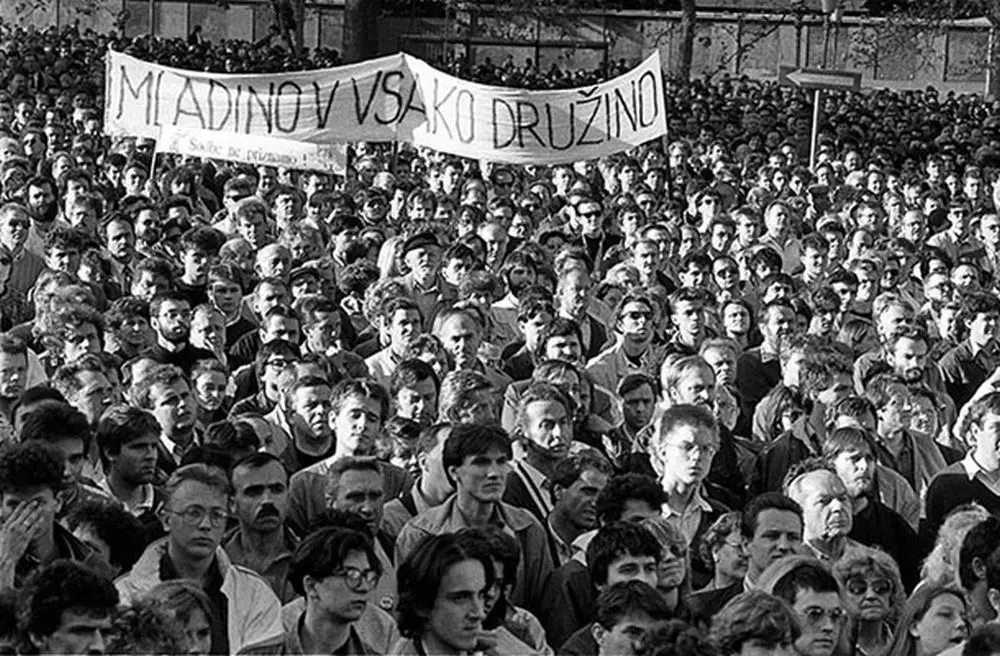
Another article by Nova24TV that followed on Monday, takes a similar path with regard to newspeak on contemporary sources of totalitarian danger. The author finds the Hungarian diplomatic protest “reasonable” since “if you were labelled Nazi by the media in the former Eastern bloc, which also included Hungary and Slovenia, it meant you were already on your way to gulag or being covered by soil. Also in Slovenia. The reaction [to the Hungarian reaction] bares a witness that this tradition is still alive. When a leftist weekly calls you a fascist, you aren’t even allowed to express your disagreement.”
If we may interrupt this narrative with a little correction – while Hungary was part of the Eastern Bloc and one of the Soviet satellites, Slovenia was not really, and certainly not since the Tito-Stalin split of 1948. Nova24TV then continues with a speculation on possible reasons behind the “panic on the left”, caused by the Hungarian diplomatic note of protest: “it is probably a combination of pre-election time, when the left is hoping for new voters with the use of an old policy of attacking external and internal enemies (fascists and such) and fear, because Orbán in fact exposes their modes of handling and controlling the media.”
Following this, Nova24TV published another article in full support of Generation Identity, a far-right movement associated with the recent “lone wolf” terrorist attack in Christchurch, New Zealand, titled “The Truth is our Weapon Against the Mainstream Media Lies”.
Mladina: Hungary's attempts to control the Slovenian media
STA, 5 April 2019 - The left-wing weekly Mladina, which put a cartoon of Hungarian Prime Minister Viktor Orbán performing the Nazi salute on its cover two weeks ago, discusses in its latest commentary the Hungarian ambassador asking the Slovenian government to prevent Mladina from portraying Orban in such a way in the future.
Related: A Round-up of news on Mladina’s “Nazi Orban” cover
The verbal note, which is how such a letter is called in diplomacy, and which was addressed to the Slovenian Foreign Ministry, was "not very diplomatic, but unusually sharp," editor-in-chief Grega Repovž says under the headline Slovenia's Sovereignty Threatened.
"We asked for explanation and confirmation from the ministry, which said that it had received the note. The ministry answered it by saying that it consistently respected the principle of freedom of the press and expression and that it neither interfered in editorial policy of the Slovenian media, nor it assessed it."
Repovž notes that the response of the ministry headed by Miro Cerar was a response "of a serious country - cold and not allowing any debate."
The revealed diplomatic note shows how serious the situation is and who are we dealing with - not only Slovenia, but the entire Europe. "A country which dares to demand from another country's government to act against journalists means a serious security threat to the entire region."
Mladina goes on to say that Hungary is a "country which does not hide that it tries to encroach upon the autonomy of the Slovenian state with capital and all other ways."
With no reservations, Hungary has encroached upon the Slovenian political space and subordinated the opposition Democrats (SDS) of Janez Janša, whose acts have been following Hungarian political interests for quite a while.
"Through the SDS, the Hungarian state has acquired a part of the Slovenian media, which are now associated into a Hungarian national propaganda company. Of course, they represent Hungarian interests and attack the Slovenian state and its institutions."
The Hungarian government also systematically awards citizenship to the residents of the bordering region of Pomurje, makes business investments there and finances social activities. It also wanted to get an outlet to the sea through investing in the port of Koper, Mladina adds.
There are many other examples - for instance a photograph of Ambassador Edit Szilágyiné Bátorfi taken at the embassy in Ljubljana. Behind her is a historical map of a Greater Hungary, in which Pomurje is a part of it.
"They don't even bother concealing their aspirations. No serious country in Europe would tolerate such a shameless and revisionist boasting by a representative of a neighbouring country," concludes the commentary.
Demokracija: Šiško's sentencing will fall at ECHR
STA, 4 April 2019 - The right-wing weekly Demokracija says in its latest commentary that the sentencing of self-styled militia leader Andrej Šiško to eight months in prison for trying to subvert the constitutional order will fall at the European Court of Human Rights (ECHR), if not earlier, at the Constitutional Court.
Foreign Minister Miro Cerar said that the sentencing was a win for the rule of law, but he is wrong. A win for the rule of law will be when Slovenian courts stop violating the Constitution and human rights and fundamental freedoms.
"Šiško's sentencing will fall at the ECHR at the latest, and probably already at the Constitutional Court," says Jože Biščak, the editor-in-chief of the right-leaning weekly under the headline When Orwell Meets Slovenia.
"If someone who parades in a forest in the middle of the day, who wants change of the authorities and who wants to establish a Štejerska Land records all of it and publishes it on the internet subverts the constitutional order, then we are really pathetic."
If the police and prosecution react before anything happens at all, everything is probably a show for the public, if not paranoia. "Now think about the numerous (also publicised) cases of violence when the state was able to intervene in schools and families only after the fact."
This is why the question why the Šiško case was given a different treatment while practically nothing happened is not only a rhetorical one, concludes the commentary.
All our posts in this series can be found here
STA, 5 April 2019 - The weekly Mladina revealed that the Hungarian embassy had protested with the Foreign Ministry asking it to intervene over a Mladina cover portraying Hungarian PM Viktor Orbán as a Nazi. The news prompted condemnation from journalists and a joint session of the parliamentary culture and foreign policy committees is to be held to discuss the issue.
The ministry confirmed it had received a verbal diplomatic note from the embassy protesting a "politically irresponsible cover of Mladina" from 22 March and asking the ministry for "assistance in preventing similar incidents in the future".
The cover shows cartoons of the Slovenian Democrats (SDS) head Janez Janša, SDS deputy Branko Grims and SDS MEP Milan Zver snuggling with the towering Orban, who performs the Nazi salute in front of a Hungarian flag with the Slovenian coat of arms.
The note says that the "cover violates the principles of freedom of the press and expression and that the acts such as the publication of the cover harm the otherwise excellent bilateral cooperation of our countries".
The ministry answered by saying it "consistently respects the principle of freedom of the press and expression and that it neither encroaches upon editorial policy of the Slovenian media, nor assesses it."
The weekly said that the note followed a letter sent to Mladina by Ambassador Edit Szilágyiné Bátorfi, in which she said that Mladina did not strive for friendship between the two nations and that its articles did not reflect facts.
Also writing about the cover this week was Orbán's spokesman Zoltán Kovács, who said he was "not surprised by the historically confused and unprofessional stance of Mladina", which he labelled the "former mouthpiece of the Communist Party".
The weekly attributes Hungary's reaction to the cartoon going viral last week in the public, with "almost all of the remaining independent Hungarian media reporting on it".
The embassy's note was condemned by the Slovenian Journalist Association (DNS), which said the embassy wanted the ministry to "encroach upon the editorial autonomy of a media outlet", and that it was "proof of the seriousness of the situation in the so-called democratic Europe."
The association said that the embassy's comments were not only completely unacceptable, but also an "unheard-of expression of a conception of complete control and disciplining of the media by the authorities".
"At the same time, the note is another concrete example of how the government of an officially democratic country, a member of the EU and NATO, perceives the role of the media in society," the DNS added.
A joint session of the parliamentary culture and foreign policy committees is to be held to discuss the note.
The session was requested by coalition Modern Centre Party (SMC) deputy Gregor Perič, who welcomed the "determined response by the ministry", labelling the Hungarian embassy's request as "completely unacceptable".
"It points to a huge departure of the Hungarian authorities from freedom of the press as it is generally understood by the majority in the joint European family," added the member of the EU Affairs Committee.
The chair of the Foreign Policy Committee, Matjaž Nemec of the coalition Social Democrats (SD), welcomed the initiative and said he expected the joint session to be called within the shortest possible time.
"Such inadmissible (non-)diplomatic pressure should be opposed in the most determined manner possible," Nemec said, adding that freedom of the press was one of the fundamental values of Slovenian society.
The chair of the parliamentary Culture Committee, Violeta Tomić of the Left, also supports the idea of the joint session. She said that in Hungary critical and free media had virtually disappeared under Orbán.
Mladina said that many tenured diplomats said they had never seen such a note. Roman Kirn, the former foreign policy advisor to the prime minister, said "such notes are unusual for countries where freedom of the press is respected."
The weekly said Hungary's influence on Slovenian politics was not negligible. "The largest Slovenian parliamentary party, the SDS, is today the biggest debtor to Orban, whose regime controls a part of internal affairs in Slovenia."
"We had the opportunity to learn this during the debate within the European People's Party (EPP) on the expulsion of Orban's Fidesz from the group: the Slovenian representatives defended him the most," added Mladina, which also dedicated today's editorial to the issue.
In the commentary, editor-in-chief Grega Repovž said the protest note was "not very diplomatic, but unusually sharp," and added that the response from the ministry was a response "of a serious country - cold and not allowing any debate."
Referring to Hungary, Repovž said that the entire Europe was dealing with "a country which dares to demand from another country's government to act against journalists", labelling it a serious security threat to the entire region.
He went on to say that Hungary was a "country which does not hide that it tries to encroach upon the autonomy of the Slovenian state with capital and all other ways."
All our stories about Hungary and Slovenia are here, while all those about Mladina are here
The Balassi Institute is the Hungarian cultural centre in Ljubljana, where you’ll find art, music, performances, readings, literature, workshops, screenings, lectures, parties, cooking and more, all of which serve to bring a flavour of Slovenia’s eastern neighbour to the capital.
I recently visited to learn more about the place, and sat down to drink coffee and record a conversation with Institute’s director, Bíborka Molnár-Gabor.
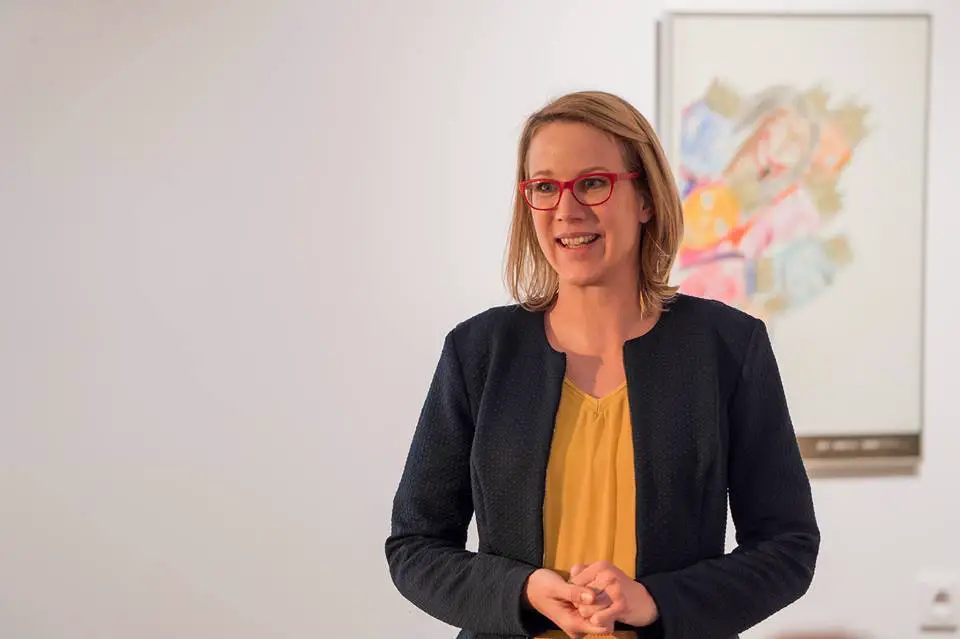
The Institute's director, Bíborka Molnár-Gabor, speaking at an event
How did you come to be in Ljubljana?
I arrived in Slovenia in 2010, and I came here for work. At that time only a few of us were speaking Slovenian in the Hungarian Ministry of Foreign Affairs, and so that was a big advantage for the job of cultural attaché in Ljubljana.
Did your family speak Slovene in Hungary?
No. I learned Slovene at the university in Budapest, but as a hobby, not main subject. Of course, there are minorities on both sides of the border, so there are some people who speak Slovene in Hungary for family reasons, but out of interest, not so much.
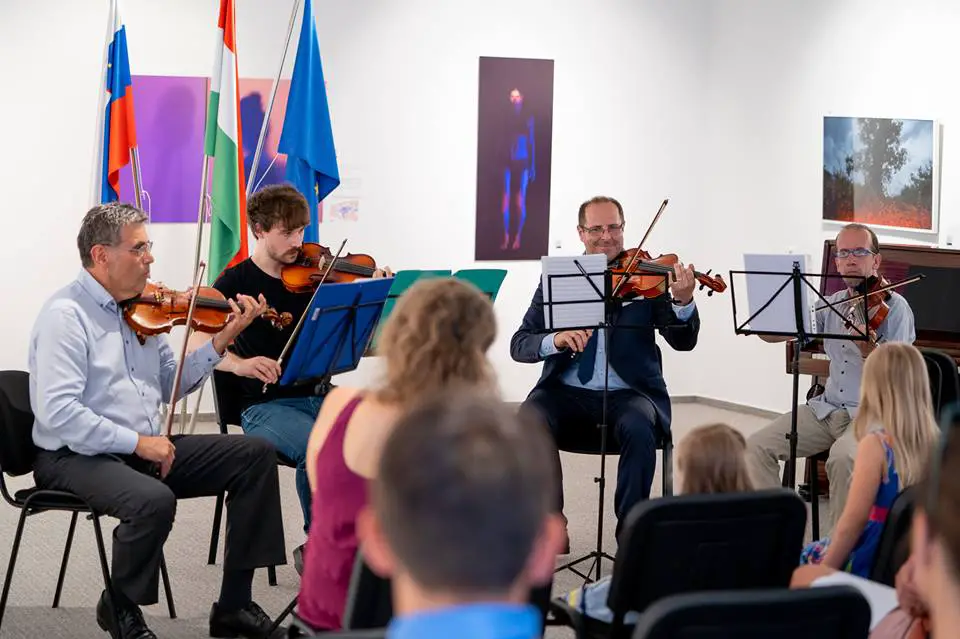
There are regular musical performances, all free...
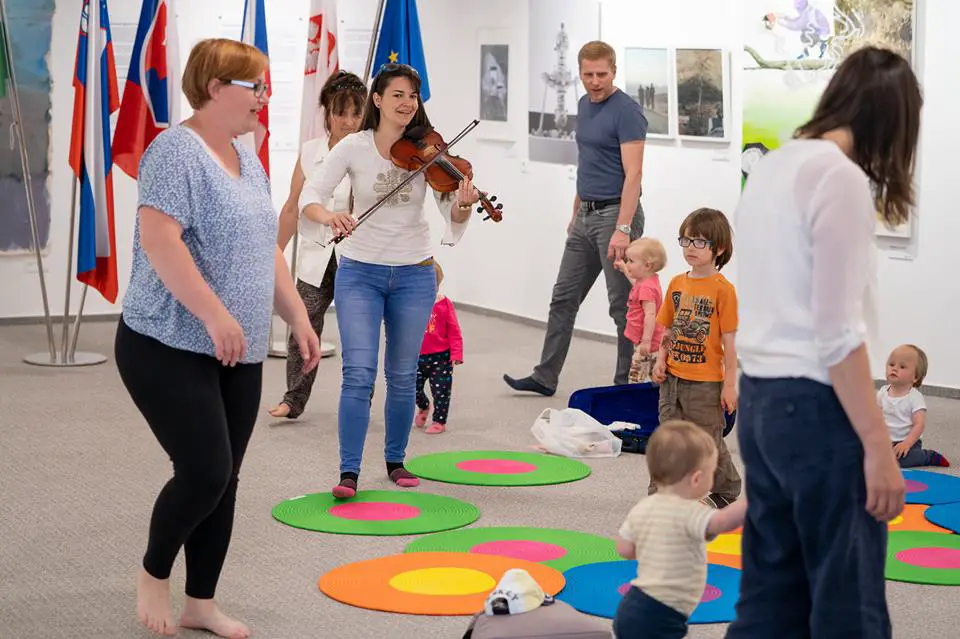
...including events for even the youngest audiences.
How did you make the move from the Embassy to the Institute?
By training I’m an economist, , and so after the posting at the embassy, I was also working at Ernst & Young, in tax advisory. Then when the Balassi Institute opened in 2016 I applied for this position, because I wanted to stay in Slovenia and help build connections between the two countries, and I like it here. I think after three years we’ve had some good effects, in terms of creating a more favourable image for Hungary, of helping people to understand the country and its culture, and of course to get more familiar with the language.
Related: Meet the People - Éva Schwetter, a Hungarian teacher in Ljubljana
And does the Institute only focus on culture?
That’s a lot of our work, but not all of it. For example, we also cover travel and tourism, and so people can come here and ask any questions they have about that. And there’s education, too, so if people would like to study in Hungary they can also come here for advice. But for business issues, and political ones, that’s the Embassy’s work.
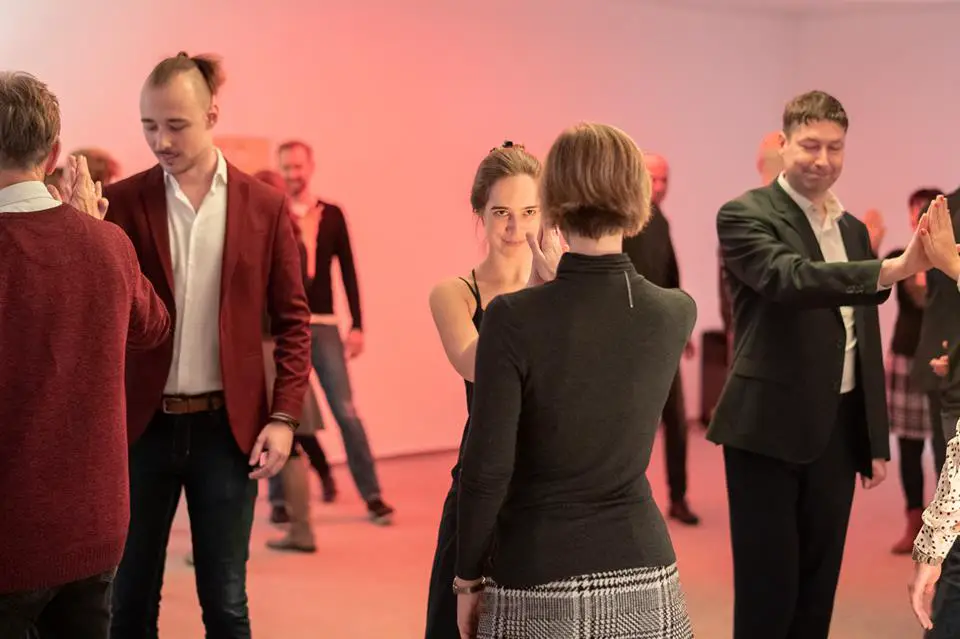
There's also dancing...
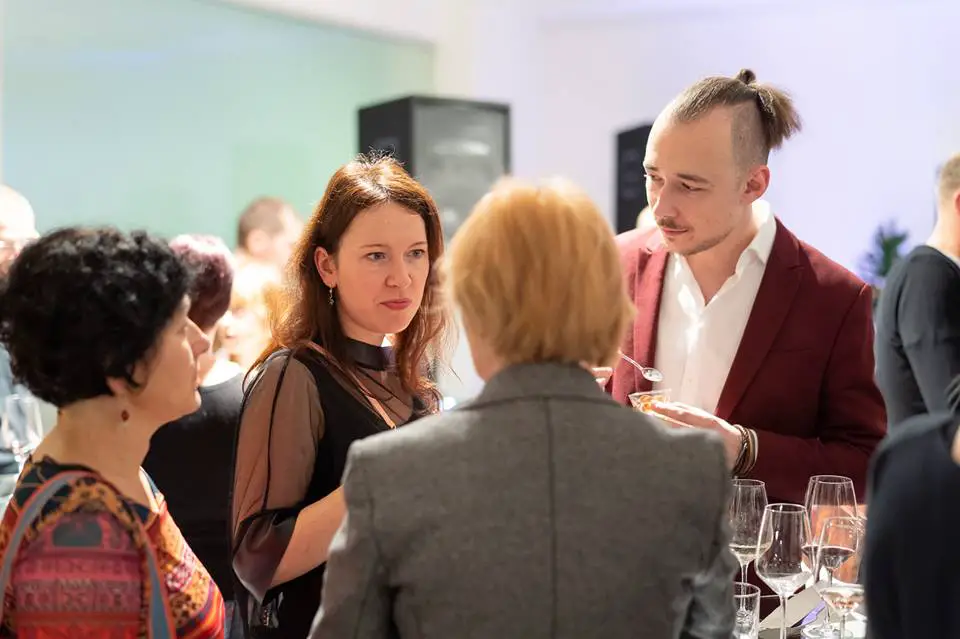
...and drinks.
You organise a lot of events – musical, culinary, literary, and so on. Are these open to everyone?
Yes, and most of them are also free to enter as part of the promotion of Hungary. However, sometimes when we work with Slovenian partners outside of the premises of the institute there’s a small entrance fee, which goes directly to our local partners. The events are also unticketed, with no reservations needed, so if people see something the like they can just come along. (The schedule is here)
How much freedom do you have with the programme?
We have quite a free hand here, because the theory is that the head of each Institute knows the country they’re based in well, and understands the points of contact and connection with Hungary. Of course, we have to hand in yearly plans that need to be confirmed by the Ministry, but these are usually approved, with very small changes. The Culture Board at the Ministry also prepares a package of proposals each year, and the Institutes can choose from those.
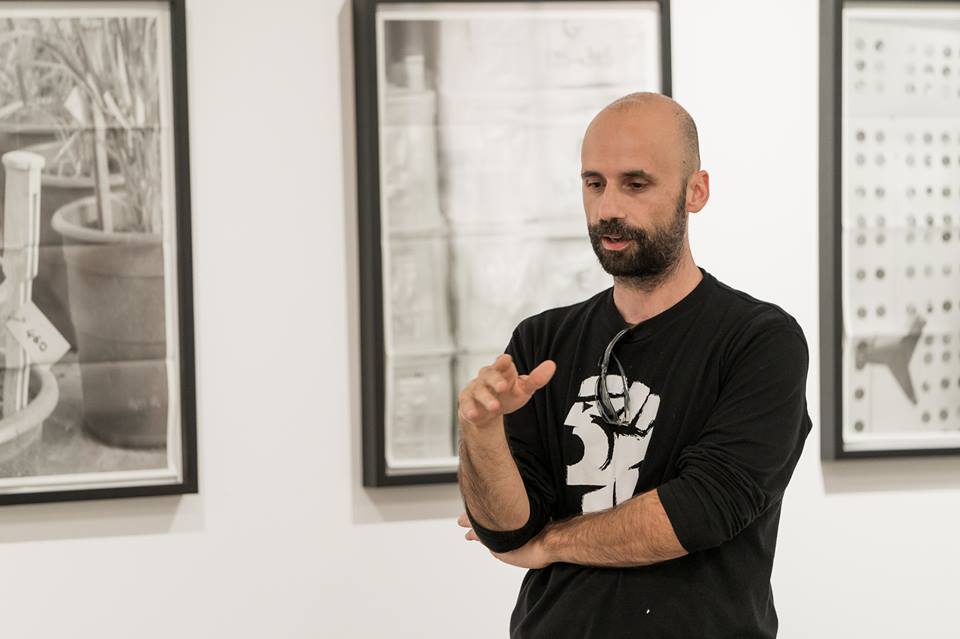
Visual art...

...and debate.
What are some events you’d like to highlight?
We have a lot of variety – art, music, literature, film, and a lot of activities for children. For example, we have regular music workshops for children, suitable for babies too, and every second Tuesday, 18:00, we have folk dancing with a teacher. Personally, I most enjoy the literary series. In 2019 we’re working with more Slovenian publishing houses to promote some translations of Hungarian literature, with some of the authors coming here for talks, and that should be very interesting.
Will they be in Slovene?
Hungarian and Slovene, I think, because we’re in Ljubljana. We do have some materials in English, and some events. For example, we often show films, and if a film has already been shown in Slovenia, on TV or in cinemas, then it has Slovenian subtitles. Sometimes there are also English ones, so we try and engage as many people as possible here. People can also use English or Slovene with any of the staff here. Two of us are Hungarian.. Then we have two local staff, one of whom is from Prekmurje, so she grew up speaking Hungarian.
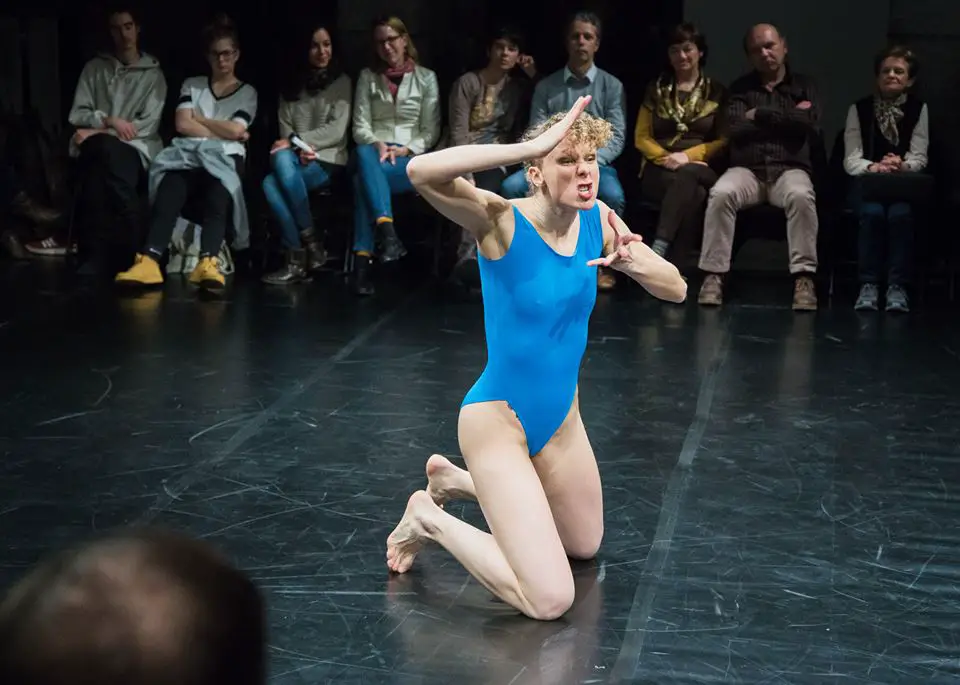
Performances...

...and competitions.
Finally, what's something from Slovenian culture that you’d like to introduce to Hungary?
I think contemporary art in Slovenia, especially film and video installations, is very good, and at least as strong as in Hungary, so I’d like to show that in Budapest.
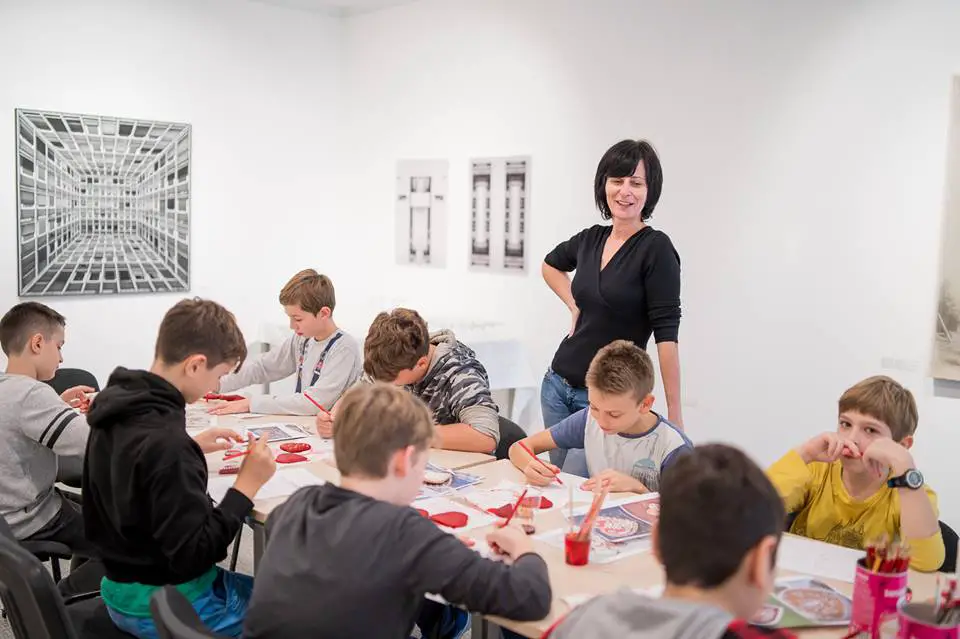
Workshops...
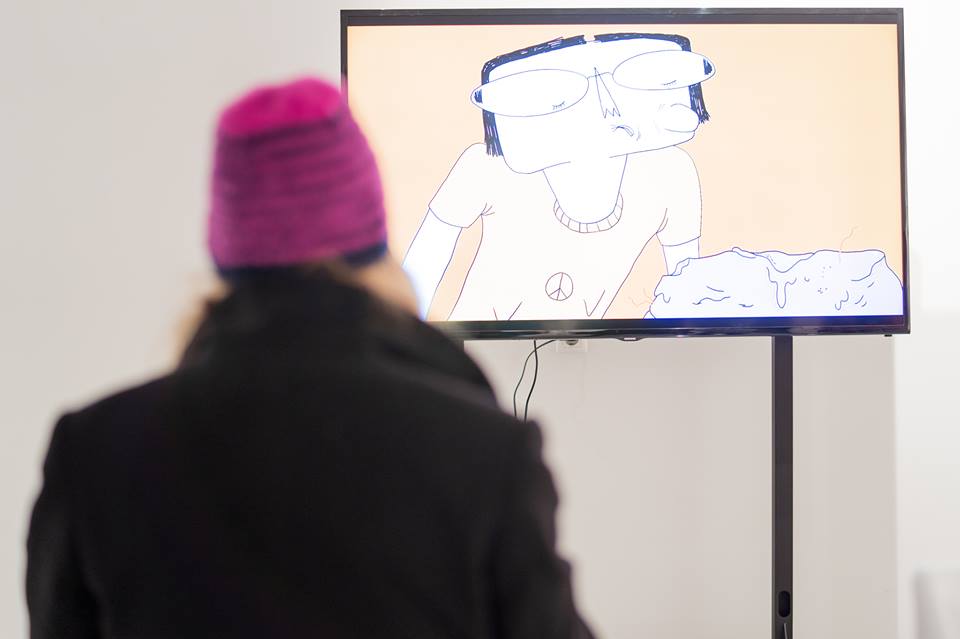
...and other things of interest
You can visit the Balassi Institute at Vila Urbana, Barvarska steza 8, which is just a short walk from Dragon Bridge going out of town on the Castle side of the river, next to a Spar. It’s open 11:00 to 19:00 Monday to Friday, unless an even runs longer, and you can see the current schedule here.
STA, 20 December 2018 - The National Assembly formed on Thursday a parliamentary inquiry into financing of political parties from abroad on an initiative from the coalition and the opposition Left. It will focus on the allegedly suspicious financing of the centre-right opposition Democrats (SDS), which believes it is an attempt to hamper its work.
The commission is to determine possible violations of the law prohibiting financing of parties from abroad and the role of the media in the financing.
The parties based their request on a report by the Court of Audit with the SDS, the only implicated party for the moment, but Jani Möderndorfer of the Modern Centre Party (SMC), who is to be appointed commission chair at its next session, said that the inquiry could be expanded if there were indications of other parties' questionable actions.
According to Möderndorfer, there was controversy about the financial support that companies with alleged ties to Hungarian ruling parties provide to some Slovenian media and its effect on the election campaign.
Möderndorfer mentioned the media house Nova24TV, magazine Škandal24 and the weekly Demokracija, whose ownership is linked to the SDS and Hungarian investors.
Related: New York Times examines Orban’s media allies in Slovenia
The commission will focus on the events between 2012 and 3 June 2017. The provisions on the financing of political parties stepped into force in 2012.
Robert Pavšič of the Marjan Šarec List (MLŠ) said on behalf of the initiators that the potential result of the inquiry could be thorough changes of legislation regulating money laundering prevention, financing of parties and election campaign and issuing and financing of media during election campaign.
Möderndorfer said that the inquiry had been endorsed because the issue had been dealt with already in the previous term and that the findings of the inquiry on suspected money laundering in the NKBM bank would also be included in the investigation.
He said that the SMC would propose at the first session of the commission that the Court of Audit be called to inform the MPs whether any party other than the SDS had "problems with financing".
Marko Koprivc of the Social Democrats (SD) said that it should be established what was wrong with the system which allows for suspicious financing of parties.
Koprivc added that the loan given to the SDS by Bosnian citizen Dijana Đuđić, who appears to have used NKBM accounts to extend millions in suspicions loans in Slovenia, and the suspicious manner of financing of the media owned by the SDS should be finally investigated.
Related: Politico on Janša and Orban
Franc Jurša of the Pensioners' Party (DeSUS) said that the inquiry could indirectly help strengthen the system of prevention of money laundering, financing of terrorism and tax evasion.
Nataša Sukić said that the law and supervision of transparency and lawfulness of financing of parties and election campaigns cannot keep up with the increasingly innovative and complicated financial flows, with the SDS being a leader in this department.
"The funds being transferred between foreign countries and the party are increasing. We are talking about a propaganda machine financed from Orban's Hungary, about money laundering suspicion, illegal transactions and interference in Slovenia's internal matters."
The SDS meanwhile believes that it is about the left-leaning coalition attacking the SDS. "It is more than obvious that the purpose of the inquiry is to get insight in the guts of the SDS, discredit it maliciously, try to paralyse it and hamper its work," deputy Dejan Kaloh said.
Kaloh added that the subject of the inquiry should be expanded with the question of how much foreign capital was involved in the promotion of the five coalition parties and the Left and "what share of the commission the leading officials in the LMŠ received from the EUR 1bn laundered for Iranian terrorists through the state-owned NLB bank."
The assumed audience for TSN isn’t only English native speakers, but anyone with an interest in Slovenia who can’t yet understand the local media, as well as Slovenes who’re interested in a different perspective on the land they call home. We thus leapt at the chance to visit the Balassi Institute in Ljubljana (Balassijev inštitut Ljubljana - Balassi Intézet), the Hungarian cultural centre not far from Dragon Bridge, to carry out some interviews and learn more about how people from just over the border might see life here.
The first of these, presented below, is with Éva Schwetter, a language teacher who’s lived in the capital for seven years, and is working to enhance relations and understanding between these two neighbouring states.
What brought you to the Institute?
I was as a guest teacher at the university in Ljubljana for six years, but I was also teaching here, so when the university job ended I started working at the Institute most of my time. It opened in January 2016, and I’ve been teaching Hungarian since a few months after that.
Now I have around 30 students in five groups, both at the Balassi and SAZU. Quite often there are researchers, and what they’re interested in crosses over the border into Hungary, and that’s where I can help.

One of the many and varied activities at the Balassi Institute
Who takes the classes here?
We get all ages, and sometimes they’re just interested in the language, but usually it’s because they have some connection, a boyfriend, girlfriend, or maybe some family history with Hungary. So we have classes for beginners, but also for those who already speak good Hungarian and still want to practice and improve.
The classes are open to everyone, although there’s a fee. The first semester starts in October and the second in February, sometimes in March, with a beginners group in each. I teach the beginners in Slovene, but over time, as the students learn more, I use more Hungarian. I have one group who’ve been coming for five semesters, and now it’s almost completely Hungarian.
How different is Slovene to Hungarian?
It’s a totally different language family, Finno-Ugric, so the structures and logic are not at all the same. Hungarian is very logical, but it has its own logic, and it usually takes two or three semesters to get into it.

The Balassi Institute
What else is difficult?
Most people say it’s the vocabulary, which is very different to anything they’ve seen before. It’s even different to Finish and Estonian, other Finno-Ugric languages, because they’ve been separate for 3,000 years. So it’s not like Italian and French, but more like French and Persian.
Hungarian also uses a lot of suffixes, and that’s new for most people. What would be a structure in English or Slovenian is one word in Hungarian, but with two or three or four suffixes. It’s like Lego, and you just keep adding things, not taking away.
So in my experience, and that of my students, it’s difficult to start, but then it gets easier, and with the writing it’s written how it sounds. As a written language Hungarian has a long history, going back about a thousand years. First runes, then from around 1000 AD we implemented the Latin script at the same time as the formation of the Hungarian Christian Kingdom.
Has your experience as a learner of Slovene made you a better teacher of Hungarian?
I think so, yes. A lot of Slovenians are scared of Hungarian because of all the differences, but the problems go both ways, and when they see that I can speak Slovene then they know it’s not impossible. At first I spoke very little Slovenian in class, and I told the students to be patient, but they really appreciated my efforts, and it also helped when they faced difficulties in speaking Hungarian. Plus I think the relationship between a teacher and student is helped when both sides see the effort being made.
The new textbook that Éva worked on
You recently worked on the first textbook specifically for this market, Hungarian for Slovenians. Can you tell me a little about that?
Well, after working here for some years I knew the problems that students have with certain things, and that made writing the book easier. So that experience has gone into the book, and of course if something is very similar, or very different, between the two languages we emphasize that. We also focus on the common words. There are about 500 or so of those, which have Slavic roots in the both languages.
Does Hungarian have the dual?
Not like in Slovene, but we do have a special case for when I (first person, singular) am doing something to the second person (singular or plural), like if I see you, I call you, I love you.. And we don’t have gender, so all those declensions don’t exist. There are also things like two conjugations, depending on whether the object of the verb is definite or indefinite – I see the book or I see a book.

The Balassi Institute
What’s difficult for you in learning Slovene?
For me the gender is difficult, because we don’t have this in Hungarian, and all the combinations of singular, plural and so on, but today I can of course read newspapers, watch TV and give a class.
What surprised you about life in Slovenia?
Ljubljana is a small town, and that was a shock to me, after Budapest. And it surprised me how much people value their private time, so the busiest time on the road is after 3pm, as people leave work from then on. Also, if I send an email in the evening or over the weekend then I can’t expect a reply until they’re back at work, which I respect and understand, but it was still a shock.
I was also surprised by how much English people speak here, especially in Ljubljana. Of course, that makes things easy, but it’s also frustrating when you start using the language, because when you pause and try and think of a word people often just start talking in English.
Finally, I think Slovenes are more direct than Hungarians. For example, when Hungarians send emails they will say a lot, and not just get to the point. But here people will just ask for something, no polite forms, just business. So this offended me at first, but now I think it saves time and I also send these kind of messages.

The Balassi Institute
What about food and drink?
It’s really not that different, but we were part of the same Austro-Hungarian Empire, so maybe that’s not so strange, and a lot of the food in Prekmurje is the same as just over the border, with even the famous gibanica being very similar to the Jewish cake flódni, which is well known in Hungary. One thing that’s different, and maybe interesting to your readers, is bograč. In Hungarian this is the thing you cook in, like a cauldron, say, but in Slovenian it refers to the food inside, like a goulash.
Do you think you'll stay in Slovenia?
I love it, I feel integrated, and my life is here. After seven years I can’t imagine leaving, so I want to stay as long as possible. Learning Slovenian helped a lot, of course, because speaking the language opened some doors that had always been closed to me. And Ljubljana, where I live, is beautiful, clean, and friendly. When there’s a problem the attitude seems to be let’s solve it together, and I like that.
You can learn more about Éva Schwetter’s work at the Balassi, and perhaps attend an event if you don’t take a course, by visiting the institute’s homepage or Facebook, or just going in person next time you’re in town.
Ljubljana has a surprising number of film festivals, and after November’s LIFFe and the LGBT+ programmes it’s time for Animateka, the International Animated Film Festival. This runs from December 3rd to the 9th and from around 11:00 to 21:00, mostly from 15:00 on, showing at Kinoteka (Cinemateque in the schedule) and Kinodvor, with other events at Museum of Contemporary Art Metelkova (MSUM+) and Elektra Ljubljana. In addition to the programme of features and shorts from around the world, this year animation from Hungary is a particular focus. Another major part of the festival is Slon [The Elephant], promising “the finest animated films for children”, with a PDF of that schedule here.
Of course, animation isn’t just for kids, and there’s also the “adult” section for those aged 14 and over (here).
There are also workshops offering, among other things, hand-drawn animation for those aged 11 to 15, green screen animation for kids aged 7 to 11, an optical toys workshop for children 11-15, and a flip-book making class (ages 8 to 12). And if you’re a little older, and perhaps work (or would like to work) in the industry, then note that there’s also a section for industry professionals with master classes, talks and panel discussions. Learn about that side of Animateka here.
And if you can’t make any of the scheduled events then there are exhibitions, including one on VR and 360 degree gaming being held at the Museum of Contemporary Art Metelkova, and another looking at the work of Špela Čadež at Kinodvor. Finally, one focus of the event is a competition, with the screenings for that here.
Related: Animator Špela Čadež Gets Retrospective in Italy (Videos)
In short, whether you’re free during the week or at the weekend, an adult or a child, if you like animation, or just would like to learn more about what the art’s been up to over the last year or so, then be aware the Animateka festival is back in town, and there’s a chance for you to enjoy it in the next few days. The official website, in English, is here.
Mladina: Why is Cerar so friendly to Hungary?
STASTA, 23 November 2018 - The left-wing weekly magazine Mladina analyses on Friday Slovenia's conduct towards Hungary regarding its participation in the Koper-Divača rail expansion. It wonders what was behind the former Miro Cerar government's push for Hungary's involvement and its lenient treatment of the neighbour's plans to extend influence in Slovenia.
Hungarian PM Viktor Orbán has pulled out of the rail expansion because he changed his mind when realising he bet on the wrong horse, editor-in-chief Grega Repovž says under From Hungary to Koper, noting Orbán counted on his EPP "comrade" Janez Janša, into whose media outlets he has invested a lot of money.
If Janša was in power, Orbán would probably already be buying ships to create a Hungarian fleet, Repovž says in reference to Orbán's statement that he wanted to make the Slovenian port of Koper Hungary's gateway to the world.
He also made it clear, as he visited the Hungarian minority in the Slovenian town of Lendava last week, that Cerar's government had promised Hungary 50,000 sq. meters of land in Luka Koper, that is a position which would enable it to form its own fleet.
What Repovž finds particularly intriguing is former Prime Minister Cerar's conduct in relation of Orbán's "attack" on Luka Koper, which operates the port of Koper.
He finds Cerar's enthusiasm about the rail expansion towards Koper incomprehensible in the first place, saying expanding the port on the small Slovenian coast is not the only development option.
The editor notes that with 200 million euro, the amount Hungary would contribute for the rail expansion, miracles could be made with more environment-friendly projects.
Nevertheless, Cerar was pushing for the port's expansion despite potential environmental issues.
He also insisted on Hungary's participation despite being aware that Orbán was betting on somebody else in Slovenia and that by sponsoring Janša and his Democrats (SDS), he was in fact undermining Cerar.
Cerar's conduct was "totally illogical", even more so because he in fact supported the potential of a country which is Slovenia's competitor.
What is also puzzling is that Cerar's government silently accepted Hungary's extending its influence in the Slovenian region of Prekmurje, where it is making investments and granting citizenship to members of the Hungarian ethnic minority.
Repovž wonders what was behind the Cerar government's benevolent treatment of Orbán's plans and why he was so outraged when Orbán announced to pull out of the rail project.
Demokracija: Sickened by Janković's victory in Ljubljana
STASTA, 22 November 2018 - The right-wing weekly Demokracija deplores the election victory of Ljubljana Mayor Zoran Janković in the latest editorial, expressing concern about an emerging "kleptocratic axis" between Ljubljana, Maribor and Koper.
The editor-in-chief Jože Biščak says that Janković is running the capital city in a kleptocratic, corruptive and morally perverted way; "by awarding some kind of LGBT certificates to schools and kindergartens he indoctrinates the youngest with an ideology that defies common sense and Catholicism".
Biščak is also critical of the Catholic Church for not publicly endorsing Janković's challenger in Sunday's election, Anže Logar of the Democratic Party (SDS), suggesting this would be appropriate because of Janković's "arrogant and contemptuous attitude to Catholics".
"It would be too cheap to point the finger at the Church for making a new victory possible for Janković. No. Ljubljana remains the breeding ground of organised criminal rings and corruption, the city of the sheriff 10% who is distributing bread among parasites, consultants and the leftist city elite.
"This company, including the non-natives who have turned the capital into a little Yugoslavia, was obviously large enough for a victory at the given turnout."
However, Biščak also says that Anže Logar activated more of the electorate than anyone would expect and that the proportion of the vote he won indicates an inevitable end to Janković's parallel economy.
Biščak also expresses concern about what he terms a kleptocratic north-south axis in the headline of his commentary. He is concerned the run-offs in Maribor and Koper may be won by "persons who have the same mindset as the Ljubljana sheriff. Boris Popović has 'proved' himself, and Saša Arsenovič (if he defeats Franc Kangler) certainly will as he has said it publicly that Zoran Janković is his mayoral role model."
Referring to the poor showing of the ruling coalition, Biščak says that such a result would send party heads rolling in developed democracies. He also rebukes the left bloc for failing to file top-tier mayoral contenders in Ljubljana and Maribor.
However, he offers the higher turnout as proof that "political apathy is over and that a large part of the country that is not related to urban municipalities is healthy and not yet infected with the immoral leftist agenda".
Other articles in this series can be found here
STA, 20 November - While Hungarian Prime Minister Viktor Orbán announced last week that the country was withdrawing from the investment in the Koper-Divača rail project, Foreign Minister Péter Szijjártó said on Tuesday as he paid a visit to Slovenia that the option remained open, Radio Slovenija reported.
According to the national radio, Slovenian Foreign Minister Miro Cerar has obviously convinced his Hungarian counterpart that the Slovenian government is yet to decide on the neighbour's participation in the project.
Szijjártó, who is visiting Slovenia upon an invitation from Cerar, told Radio Slovenija that the Slovenian government had not yet decided on Hungary's participation in the construction of a new rail line between the port of Koper and the Divača inland hub.
"My good friend Miro Cerar informed me that we should not understood the statements by your infrastructure ministry as the decision of the Slovenian government," the Hungarian foreign minister said.
Infrastructure Minister Alenka Bratušek said on Monday that Hungary was interested in the project to get a piece of the Slovenian coast and that that would never happen.
"If this is the reason that [Hungary] will not be involved, then be it," she added and reiterated that Slovenia was able to build the rail on its own.
Szijjártó today labelled Bratušek's statements as discouraging. "We had achieved great progress in the time when Cerar was your prime minister," he told Radio Slovenija.
According to hum, Hungary is also looking for opportunities in other ports. In Koper, the landlocked eastern neighbour transships two million tonnes of cargo, which is 10% of total transshipment in the port.
Szijjártó is in Ljubljana today for the opening of the 34th Slovenian Book Fair, where Hungary is the guest country.
Szijjártó and Cerar had a working meeting at Strmol Castle to confirm the excellent bilateral relations and regular dialogue between the countries, following the official visit at the end of October by Hungarian President Janos Ader.
What connects the countries is the protection of ethnic minorities from both sides of the border, the Foreign Ministry said in a press release.
Szijjártó and Cerar also discussed economic cooperation, investment opportunities, cross-border infrastructural projects, including power lines and gas pipeline connections between the countries, and topical EU and international issues.
All of our stories related to Hungary can be found here


